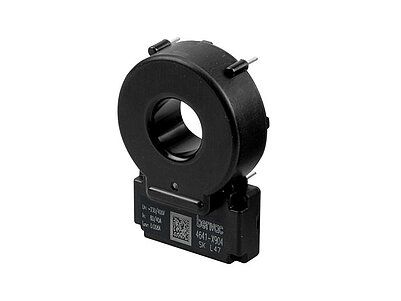

Level 1 AC charging involves charging the electric vehicle from a normal outlet at home but requires a special charging cable. This charging cable must have an integrated monitoring system capable of triggering a 6 mA ground fault. These are known as charge current interrupting devices or CCID5. Bender offers ground-fault monitoring sensors for level 1 charging cable manufacturers (level 1 GFCI). These CCID sensors can be used in EVSE cords in accordance with UL 2231 which has several Bender listed devices.
Level 2 EVSE can be found at home, in hotels, or at the workplace. The required infrastructure for those charge ports is relatively simple and usually requires only a 120v or 240v connection. Bender's RCMB level 2 ground fault sensing devices monitor circuits effectively for fault currents that can pose hazards to personnel and equipment. These level 2 mA sensing leakage devices are listed to UL2231 and fulfill all the stringent safety requirements.
DC charging allows vehicles to be charged quickly at significantly higher powers. A DC charging station, also called a quick charging station, is usually set up as an unearthed power supply system, which must be monitored by an IMD as specified by the standards.
The concept of quick charging is ideal for short-term recharging during a break at a motorway service station, for example. With increasing battery capacity, the topic is also becoming interesting in the home sector. This is because some vehicles only offer an AC charger with 3.7 or 7.4 kW for larger batteries, which may not leave the battery fully charged overnight. This means that the need for DC wallboxes is also increasing for private spaces.
In DC charging, a distinction is made between two common charging standards. In addition to the CCS standard (Combined Charging System) used in Europe, the Japanese charging standard CHAdeMO (after "CHArge de MOve") is also used for most vehicles from Asian manufacturers.
Both standards differ in the requirements for monitoring the DC charging process. This concerns both the required disconnection times and the limit values for disconnection in the event of a fault, as well as monitoring for symmetrical or asymmetrical faults. Until now, two different devices were necessary for this purpose.
The new insulation monitoring device ISOMETER® isoCHA425HV in combination with the coupling device AGH420-1 supports both charging standards equally. With this combination unit, Bender has now responded to the demands of the market.
It allows switching online between CCS and CHAdeMO via a galvanically isolated Modbus RTU interface. The individual parameters for the respective standard are already stored and can be selected automatically. The device is designed for nominal voltages of up to 1,000 V and thus already takes into account the increasing battery voltages.
To prevent the insulation monitoring device in the vehicle and the one in the charging station from influencing each other, the device in the vehicle is usually deactivated during the charging process. The insulation monitoring device in the charging station then monitors the complete charging circuit.
| Name | Category | Size | Language | Timestamp | D-/B-Number |
|---|---|---|---|---|---|
| Product Overview ISOMETER®/ISOSCAN® | Product Overviews | 5.3 MB | EN | 2024/02/1616.02.2024 | |
| DATEV eG Achieves Higher Data Center Availability and Reduces Downtime Through the Application of Bender Residual Current Monitoring Technology | Technical Information | 913.0 KB | EN | 2019/05/1313.05.2019 | |
| Charging Electric Vehicles - Protection Against Electric Shock by DC Fault Current Sensor Units | Technical Article | 931.2 KB | EN | 2019/05/1313.05.2019 | |
| SensorPRO LINETRAXX® RCMB300 series - The design of resilient data centres | Application Brochures | 2.9 MB | EN | 2020/02/2424.02.2020 |
Products

Ground-fault monitoring device for ungrounded DC drive systems in electric vehicles

Insulation monitoring device with coupling device for unearthed DC systems (IT systems) DC 0 V to 1000 V Suitable for DC charging stations according to CCS or CHAdeMO
![[Translate to North American English:] isoCHA425](/fileadmin/_processed_/8/2/csm_isoCHA425_01_WEB_list_9b01ec0154.jpg)
Insulation monitoring device for unearthed DC systems (IT systems) DC 0 V to 400 V. Suitable for DC charging stations according to CCS or CHAdeMO

AC/DC sensitive residual current monitoring for AC charge stations

AC/DC sensitive residual current monitoring module for electric vehicle charging systems

DC sensitive residual current monitoring for AC charge stations

DC sensitive residual current monitoring module for electric vehicle charging systems

The next generation of smart charge controllers

Ground-fault monitoring device for ungrounded DC drive systems in electric vehicles

Insulation monitoring device with coupling device for unearthed DC systems (IT systems) DC 0 V to 1000 V Suitable for DC charging stations according to CCS or CHAdeMO
![[Translate to North American English:] isoCHA425](/fileadmin/_processed_/8/2/csm_isoCHA425_01_WEB_list_9b01ec0154.jpg)
Insulation monitoring device for unearthed DC systems (IT systems) DC 0 V to 400 V. Suitable for DC charging stations according to CCS or CHAdeMO

AC/DC sensitive residual current monitoring for AC charge stations

AC/DC sensitive residual current monitoring module for electric vehicle charging systems

DC sensitive residual current monitoring for AC charge stations

DC sensitive residual current monitoring module for electric vehicle charging systems

The next generation of smart charge controllers
In-Cable Control and Protection Device for mode 2 charging of electric road vehicles (IC-CPD)
Ladeleitungsintegrierte Steuer- und Schutzeinrichtung für die Ladebetriebsart 2 von Elektro-Straßenfahrzeugen (IC-CPD)
Niederspannungs-Schaltgerätekombinationen - Teil 7: Schaltgerätekombinationen für bestimmte Anwendungen wie Marinas, Campingplätze, Marktplätze, Ladestationen für Elektrofahrzeuge